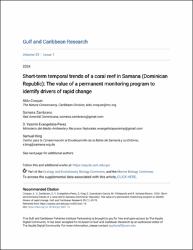/admin/item?itemID=0d939e3a-7317-461e-bb8b-85ce85d7063b
Short-term temporal trends of a coral reef in Samana (Dominican Republic) : the value of a permanent monitoring program to identify drivers of rapid change

View/
Type of Access
OpenMaterial Type
ArticleType of Content
Scientific researchSubject
Recursos naturales - República DominicanaRecursos costeros y marinos
Arrecifes de coral
Investigación ambiental
Language
EnglishCollection
- Investigación ambiental [1743]
Metadata
Show full item record| Abstract: | Abstract: Permanent monitoring programs are valuable to identify drivers of ecosystem trends. For example, in 2021, we reported the first record of Stony Coral Tissue Loss Disease (SCTLD) along the northeastern coast of the Dominican Republic, affecting major reef-building coral species with a prevalence above 30%. However, a few sites such as Carenero remained unaffected by SCTLD for almost 2 years. The average coral cover in this site was about 18–25% (mean 18.3% ± SD 1.5), and disease prevalence did not exceed 7% in the coral community. During the first quarter of 2022, a few colonies (<1%) of Montastraea covernosa, Pseudodiploria strigosa, and Colpophyllia natans started to show macroscopic signs of SCTLD, and between April and September of that year, average prevalence of SCTLD increased 4-fold. In September 2022, Hurricane Fiona affected the Dominican Republic, hitting the island’s eastern coast and moving northwest. Coral diseases such as SCTLD and Caribbean Yellow Band Disease (CYBD) increased in prevalence, reaching up to 36% among the top 5 coral reef-building species, and the average of dead colonies reached 43%. We recorded a 3-fold reduction of average live coral cover (77% lost) by the end of 2022, with Orbicella faveolata, M. covernosa, C. natans, and P. strigosa the most affected species. Furthermore, Fiona lifted and turned upside down large O. faveolata colonies, particularly in the reef flat, and severely affected a large thicket of Acropora cervicornis. Results highlight the value of recurrent and permanent monitoring programs to identify stressors affecting coral reefs. Resumen: Los programas de monitoreo permanente son útiles para identificar tendencias en los ecosistemas. En 2021 se reportó el primer registro de la enfermedad de pérdida de tejido rápido (SCTLD) en la costa noreste de la República Dominicana, afectando principales constructores de arrecifes con una prevalencia superior al 30%. Sin embargo, sitios como Carenero permanecieron sin afectarse por SCTLD durante casi 2 años, con una cobertura media de coral entre 18–25% (media 18.3% ± SD 1.5) y una prevalencia de enfermedad inferior al 7%. A inicios de 2022, menos del 1% de colonias de Montastraea covernosa, Pseudodiploria strigosa y Colpophyllia natans mostraron signos de SCTLD, pero entre abril y septiembre la prevalencia promedio se cuadruplicó. En septiembre de 2022, el huracán Fiona impactó la República Dominicana, aumentando la prevalencia de SCTLD y la banda amarilla del Caribe (CYBD) hasta un 36% en las principales especies arrecifales, con un incremento de colonias muertas al 43%. Para finales de 2022, se registró una pérdida del 77% en la cobertura de coral vivo, siendo las especies más afectadas Orbicella faveolata, M. covernosa, C. natans y P. strigosa. Fiona también levantó y volteó grandes colonias de O. faveolata y dañó severamente una gran población de Acropora cervicornis. Estos resultados resaltan la importancia de programas de monitoreo recurrentes y permanentes para identificar factores de estrés en los arrecifes de coral. |
| Author(s): | Cróquer, Aldo
Zambrano, Someira Evangelista-Pérez, D. Yasmín King, Samuel Guendulain-García, Sergio Villalpando, María F. Sellares-Blasco, Rita I. |
| Date: | 2024 |
| Published: | Gulf and Caribbean Research, 35(1), 65-78. https://doi.org/10.18785/gcr.3501.16 |
| Citation: | Cróquer, A., Zambrano, S., Evangelista-Pérez, D. Y., King, S., Guendulain-García, S., Villalpando, M. F., & Sellares-Blasco, R. (2024). Short-term temporal trends of a coral reef in Samana (Dominican Republic): The value of a permanent monitoring program to identify drivers of rapid change. Gulf and Caribbean Research, 35(1), 65-78. Recuperado de: |
| URI: | https://bvearmb.do/handle/123456789/5480
|

